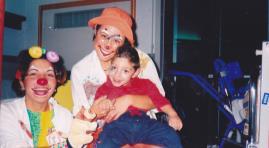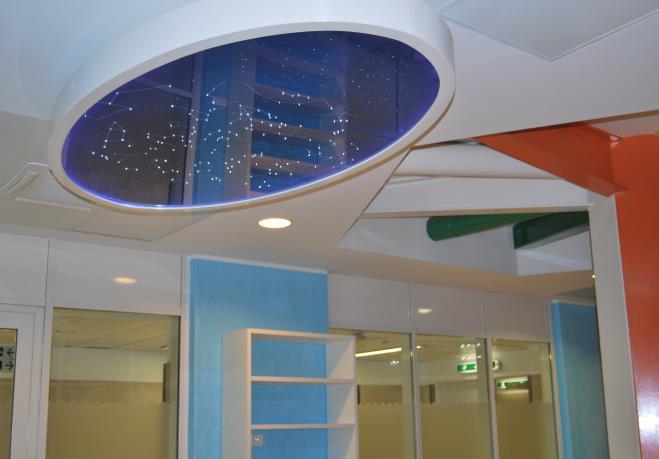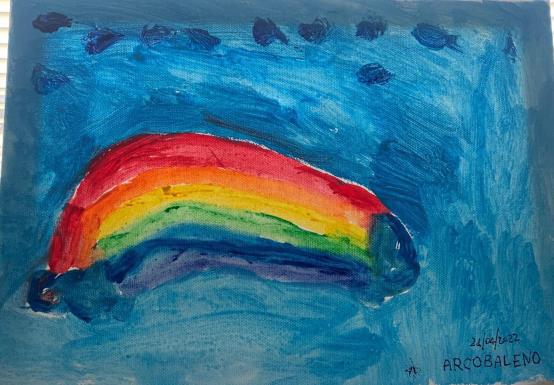The project is being implemented with the support of UNICEF Ukraine and with financial support from the Government of Norway.

Implemented by: Partner:






The project is being implemented with the support of UNICEF Ukraine and with financial support from the Government of Norway.

Implemented by: Partner:






Dr Lucia Celesti
Responsible, Public Relation Office and Accoglienza UOC
Medical Direction
Bambino Gesu Children’s Hospital Italy, EU



• According to the UN Convention on the Rights of the Child (Article 31), every child has the right to play and leisure

• Even in the hospital this right must be protected and guaranteed

• Play is an essential part of the overall care plan

• Promotes relaxation and stress reduction

• Helps decrease pain perception during medical procedures
• Encorages cooperation with healthcare staff
• Can be used as a non-pharmacological therapy





• Other activities that particularly influence the familiarization with therapeutic procedures and potentially unsettling tools used in the hospital are Art-therapy, thematic laboratories and guided imagination laboratories as well as a video archive, a library and a toy bank for loans or offers.
• Individual interventions have to be done at the bedside in Intensive Care Units. For parents who can entrust their children to a qualified staff member, meetings and shared areas or manual activities that can help them to find emotional support and playful resources must be provided to relate themselves with their child even in the hardest times.



The service in Bambino Ges˘ Hospital has two main targets: to offer children and parents care and games for entertainment and relief and, at the same time, a way to express and elaborate fears, doubts, worries and negative emotions linked with hospitalization. For this purpose, a plan of activities is required, diversified in relation to different ages and contents: spontaneous and guided games, laboratory activities such as graphical-pictorial activities, marionettes construction and dramatization, role play, manipulation and construction of clay toys and musical instruments, physical activities with music, stimulation of the imagination, reading and creation of tales and stories about peculiar themes.

• Free play : spontaneous , creative , understructured

• Guided play: proposed to promote free expression of child feelings
• Therapeutic play: used to prepare children for medical procedures
• Relational play : encourages social interaction between children and adults


• Hospital playroom : a safe , welcoming space of normality;

• Even the hospital room can become a play area;
• Importance of clean, safe, age- appropriate materials.







• Playtime becomes a moment of shared experience

• It helps reduce parents’ anxiety and strenghthens the bond
• It supports parents in hospital , maintaining an active role







REDUCE STRESS AND EMOTIONAL OVERLOAD






PROMOTE EMOTIONAL




PROCESSING



ACCOMPANY IN CRITICAL MOMENTS


Reduce stress and emotional overload

• Promote relaxation through listening and music production
• Facilitate emotion expression and regulation with educational support
• Promote body awareness and breath control through musical exercises
• Create a safe and trusting environment thanks to the collaboration between music therapist and educator
• Support emotional coping strategies through shared play and musical activities



• Express emotions that are difficult to say in words.
• Listen better through music.
• Strengthen family bonds by sharing musical experiences.
• Reduce tensions and facilitate dialogue.
• Communicate without words, useful with children or people with difficulties.
• Create positive moments and family rituals


• It helps recognize and name emotions.
• It offers a safe and creative expressive channel.
• It allows you to relive and transform emotional experiences.
• Reduces emotional blockage through sound and movement.
• It fosters self-awareness and emotional self-regulation.


• Offers emotional support during difficult situations.
• Helps contain anxiety, fear or sadness.
• Create a safe space to express yourself.
• It promotes comfort and closeness even without words.
• It makes moments of change or loss more tolerable.
• The hospital can be an environment of fear, anxiety and uncertainty

• Music promotes emotional regulation, promoting states of calm and perceptions of safety
• It is a universal language that connects emotions, memories and relationships


• Music gives voice to emotios that cannot be spoken
• It allows children to represent and transform their hospital experience
• It provide a safe space for emotional release and resilience



Evasive function







Promotes temporary detachment from reality, offering an internal space of relief and protection.
Evocative function






Allows access to deep emotions related to past experiences, facilitating their expression and processing.

Containment function



Containing does not mean repressing or denying, but welcoming and giving shape to emotions that could otherwise be overwhelming or disorganized







Different sound space




The evasive function of music therapy involves creating, through music and the therapeutic sound relationship, a space and time that are “different” from those of illness, pain, or the hospital routine. It represents a symbolic escape from the clinical reality, allowing the child to temporarily regain a sense of freedom, playfulness, and pleasure.

• Reduce anxiety, fear, and the perception of pain.
• Offer an experience of emotional and physical well-being.


• Restore the child’s active and creative role, often limited in hospital settings.



Through free or guided musical improvisations, singing, active listening, movement, or playing simple instruments (drums, maracas, xylophones…).
The music therapist helps the child build a “sound world” where they can express themselves freely, and where illness “disappears” for a while.
The focus is on imagination and musical play: music becomes a vehicle of escapism and self-expression.



The evocative function refers to music’s capacity to recall memories, emotions, and images linked to the child’s past experiences, especially positive and reassuring ones (such as family moments, familiar songs, lullabies, celebrations, or games).



• Reinforce the continuity of the self and the child’s sense of identity, often threatened by the fragmentation of illness.
• Stimulate emotional and affective memory, strengthening the bond with the child’s inner world and significant others.
• Support the processing of painful or traumatic experiences through symbolic recall.



Using familiar songs or meaningful pieces, chosen together with the child or family. Listening to or playing these sounds can recall pleasant memories, stimulate dialogue, and recreate a feeling of “home” within the hospital. The therapist encourages sound-based storytelling, where what emerges musically can later be verbalized or processed creatively.


Definition:

The containing function refers to music therapy’s ability to provide a safe emotional container in which the child can express and regulate feelings, even intense or chaotic ones, finding inner balance through sound and relational support.


• Support and regulate emotions (fear, anger, sadness, frustration).

• Offer an experience of safety, acceptance, and non-verbal understanding.
• Promote self-cohesion and a sense of trust within the therapeutic relationship.

• The therapist musically mirrors and responds to the child’s sounds, rhythms, and silences, creating a musical dialogue that contains and reflects.


• The rhythmic and melodic structure of the music serves as a symbolic boundary, providing order and continuity that help the child feel “held” even during emotional disorganization.
• In moments of pain, anxiety, or medical procedures, music can act as a “sonic blanket”, soothing and comforting the child.

War and injury deeply affect a child’s inner world
Play and art are a safe bridge between trauma and healing
Creativity allows their story to emerge gently
L., 11 years, lost her little sister during a family escape during a raid


C., 7 years, lost her mother, brother and other family members during a birthday party at home

Expressive activities
• restore a sense of safety, control and normal life
• express what children cannot say
• reduce fear and pain, fostering resilience



Encourage free and non judgmental expression
Focus on the process, not the result
Presence and empathy build trust and hope






Il presente documento Ë stato elaborato in n.xx slide da Ospedale Pediatrico Bambino Ges˘ il xxxxxx.
I contenuti sono strettamente riservati; Ë vietata la riproduzione e la divulgazione, anche solo parziale, senza il benestare scritto di Ospedale Pediatrico Bambino Ges˘.